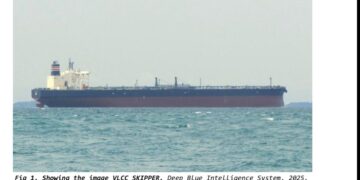The U.S. Maritime Administration has issued a new U.S. Maritime Advisory for vessels transiting the Southern Red Sea, Bab el Mandeb Strait, Gulf of Aden, Indian Ocean, Somali Basin, Arabian Sea, Gulf of Oman, Strait of Hormuz, and Persian Gulf, It incorporates new advice to U.S.-flagged vessels to turn off AIS transponders when transiting the Southern Red Sea, Bab el Mandeb Strait, and Gulf of Aden.
It also highlights Houthi deceptive communications, provides information on the new Joint Maritime Information Center, and updates other threat info.
“U.S.-flagged commercial vessels transiting the Southern Red Sea, Bab el Mandeb Strait, and Gulf of Aden with AIS transponders on are at increased risk of targeting by adversarial actors,” says the advisory. “U.S.-flagged commercial vessels operating in these areas are strongly advised to turn off their AIS transponders, unless vessel Masters believe that doing so would compromise the safety of the vessel. The International Convention for the Safety of Life at Sea (SOLAS), Chapter V, regulation 19.2.4 and IMO Resolution A.1106(29) permit vessel Masters to turn AIS off if they ‘believe that the continual operation of AIS might compromise the safety or security of their ship, or where security incidents are imminent.’”
“While vessels have been attacked by the Houthis while AIS transponders were on and while off, turning AIS off makes it more difficult to track and accurately target a vessel,” says the advisory. “Adherence to all flag state and international requirements and guidance regarding operation of AIS, and the safe navigation of the vessel, remains the responsibility of individual companies and vessel Masters.
“U.S.-flagged commercial vessels operating in these areas are advised to remain as far as possible from Yemen’s coastline without compromising navigational safety. Crewmembers should be especially vigilant when at anchor, operating in restricted maneuvering conditions, loitering, or proceeding at slow speeds.
“U.S.-flagged commercial vessels should coordinate voyage planning with U.S. Naval Forces Central Command (NAVCENT) Naval Cooperation and Guidance for Shipping (NCAGS) and consider their recommendations and guidance whenever possible. NAVCENT NCAGS stands a 24-hour watch and has the latest information on the current maritime security threats and the operational environment in this region.
“The route taken through these areas and the timing of the transit remain at the discretion of individual companies and vessel Masters. Planned routes, waypoints, and speeds should not be duplicated from prior voyages, when possible. Transiting these areas during hours of darkness may frustrate efforts to target vessels.
“U.S.-flagged commercial vessels are advised to provide hourly positional email updates to the NAVCENT NCAGS detachment when transiting these areas.
“Maritime operators are advised to alert their crews to the fact that all electronics signals from their vessels pose a risk to maritime operations and are strongly advised to secure WiFi routers while underway in these areas when feasible.”
“A missile strike on a Marshall-Islands-flagged commercial tanker in the Gulf of Aden on January 26, 2024 resulted in a significant onboard fire. U.S.-flagged commercial vessels carrying flammable, explosive, or otherwise hazardous cargoes are strongly advised to reconsider transit through these areas. However, if planning voyages through these areas, vessels should take all prudent safety precautions, including thoroughly preparing for emergency responses, and consider carriage of additional safety and damage control preparedness supplies and equipment.
“If hailed on VHF by the Houthis, or entities claiming to be Yemeni authorities, and instructed to divert from their course, U.S.-flagged commercial vessels should ignore the VHF call and continue their passage if safe to do so. U.S.-flagged commercial vessels that encounter this tactic are advised not to follow Houthi direction to divert course, as doing so may enhance the ability of the Houthis to accurately target vessels. U.S.-flagged commercial vessels are advised to update the NAVCENT NCAGS detachment when this occurs.
“If the Houthis seek to board a U.S.-flagged commercial vessel in these areas, the vessel’s Master should, if the safety of the ship and crew would not be compromised, decline permission to board, noting that the vessel is proceeding in accordance with international law, as reflected in the Law of the Sea Convention.
“When combined with evasive maneuvering, vessels transiting these areas with armed security details onboard have successfully deterred boarding by individuals in approaching small craft. The decision whether to embark a contracted armed security detail and assessment of associated risks is the responsibility of individual companies and vessel Masters, who are responsible for establishing use of force guidance and pre-planned responses for vessels carrying contracted armed security details.
“If Houthis board a U.S.-flagged commercial vessel without a contracted armed security detail onboard, the crew should not forcibly resist the boarding party. Refraining from forcible resistance does not imply consent or agreement to that boarding.
“When operating in these waters, U.S.-flagged commercial vessels should always maintain a proper, vigilant lookout by employing all suitable means in the prevailing circumstances and conditions.”
Credit: MarineLog
































































